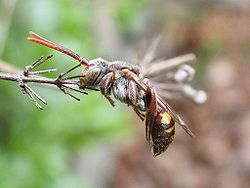Birds
A few bird species are specialist kleptoparasites, while many others are opportunistic. Skuas (including jaegers) and frigatebirds rely heavily on chasing other seabirds to obtain food. Other species—including raptors, gulls, terns, coots, and some ducks and shorebirds—do so opportunistically. Among opportunists such as the roseate tern, parent birds involved in kleptoparasitism are more successful in raising broods than non-kleptoparasitic individuals. [23] [24] Bald eagles have been seen attacking smaller raptors, such as ospreys, to steal fish from them. [25] Among passerine birds, masked shrikes have been recorded stealing food from wheatears, [26] and Eurasian blackbirds have been recorded stealing smashed snails from other thrushes. [23]
During seabird nesting seasons, frigatebirds soar above seabird colonies, waiting for parent birds to return to their nests with food for their young. As the returning birds approach the colony, the frigatebirds, which are fast and agile, swoop in to pursue them vigorously; they sometimes seize tropicbirds by their long tail plumes. The name frigatebird, as well as many of the frigatebirds' colloquial names, including man-o'-war bird and pirate of the sea, denote this behaviour. [27] However, the amount of food obtained by kleptoparasitism in the magnificent frigatebird may be marginal. [28]
Gulls are both perpetrators and victims of opportunistic kleptoparasitism, particularly during the breeding season. While the victim is most often another member of the same species, other (principally smaller) gulls and terns can also be targeted. In the Americas, as brown pelicans surface and empty the water from their bills, they sometimes have their food stolen by Heermann's gulls and laughing gulls, which lurk nearby and grab escaping food items. [29] Great black-backed gulls are skilled kleptoparasites, stealing from other gulls and from raptors. Several species of gull steal food from humans, for example takeaway food at seaside resorts. [30]
Mammals
The relationship between spotted hyenas and lions, in which each species steals the other's kills, [31] is a form of kleptoparasitism. [21] Cheetahs are common targets. Bears, coyotes and wolves are very opportunistic and all have this behavior. Crab-eating macaques have also exhibited kleptoparasitic behaviors. All hyena species engage in this behavior when they can, as do jackals. [32] Human hunters may commonly take the remains of fresh kills from other carnivores, such as lions and Eurasian lynx. [33] [34] [35] Risso's dolphins have been observed charging "head-on" at sperm whales, causing them to open their mouths; it has been suggested that the observed harassment results in some regurgitation, and that the food is then eaten by the Risso's dolphins. The behaviour is rare and may be opportunistic. [36]
A
cheetah has killed an
impala (and eaten part of it), creating a target for kleptoparasitism.
A little later,
hyenas have driven off the cheetah and are feeding.









